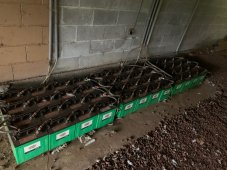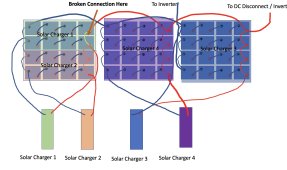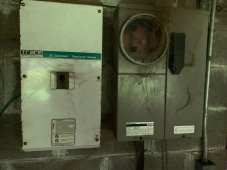Completely new to the forum and looking for some advice. This is a lot, so up front: I am very grateful to anyone who takes the time to read and offer me some insight.
I recently acquired an off-grid property that I purchased for many reasons except the house. The property was not well maintained by the previous owner, and the decently large solar system needs some immediate attention. It is very remote, and the few electricians that I can find are booked all through to mid January. I would like to at least keep the power on while I work on other things. I know basic electrical theory, but have little practical experience (I am a software reverse engineer). I am working through the DIY solar channel videos, but am starting late because I did not initially set out to buy an off-grid property. I have an immediate problem that there is a corroded positive battery cable in the large battery bank that I'm unsure how to safely replace, but also I can't evaluate the design choices of the previous owner to know if there are any more lurking issues.
The system:
Secondarily, I'm trying to evaluate if other aspects of the system are sound such as the manner the solar charge controllers are connected to the battery bank. 2 of the chargers are connected to one block of 16 batteries - splitting it, while the other 2 are connected to a whole 16 block each. Does this create uneven charge conditions and is there a better way to connect it?
Any other thoughts or advice for how to maintain this system or things to watch out for would be appreciated as I am 100% new, but have an unusual situation of inheriting a system rather than building one. And a falling apart system at that: When I first looked at the battery bank, almost all of the batteries had the bare metal exposed because they had not been watered in so long.
Thank you thank you for any insight you might bring.



I recently acquired an off-grid property that I purchased for many reasons except the house. The property was not well maintained by the previous owner, and the decently large solar system needs some immediate attention. It is very remote, and the few electricians that I can find are booked all through to mid January. I would like to at least keep the power on while I work on other things. I know basic electrical theory, but have little practical experience (I am a software reverse engineer). I am working through the DIY solar channel videos, but am starting late because I did not initially set out to buy an off-grid property. I have an immediate problem that there is a corroded positive battery cable in the large battery bank that I'm unsure how to safely replace, but also I can't evaluate the design choices of the previous owner to know if there are any more lurking issues.
The system:
- 48x 180 Watt 44 Volt, Suntech solar panels (These)
- 4x Flex Max 80 Solar charge Controllers, connected each to 4 parallel connected series strings of 3 panels
- 48x 6 Volt 225 ah golf-cart batteries, wired in 3 parallel blocks of 4 parallel connected series strings of 4 batteries for a 24 volt battery bank configuration
- Xantrex 4000 Watt SW4024 Inverter w/ Trace DC Disconnect and AC Circuit Breaker
Secondarily, I'm trying to evaluate if other aspects of the system are sound such as the manner the solar charge controllers are connected to the battery bank. 2 of the chargers are connected to one block of 16 batteries - splitting it, while the other 2 are connected to a whole 16 block each. Does this create uneven charge conditions and is there a better way to connect it?
Any other thoughts or advice for how to maintain this system or things to watch out for would be appreciated as I am 100% new, but have an unusual situation of inheriting a system rather than building one. And a falling apart system at that: When I first looked at the battery bank, almost all of the batteries had the bare metal exposed because they had not been watered in so long.
Thank you thank you for any insight you might bring.








